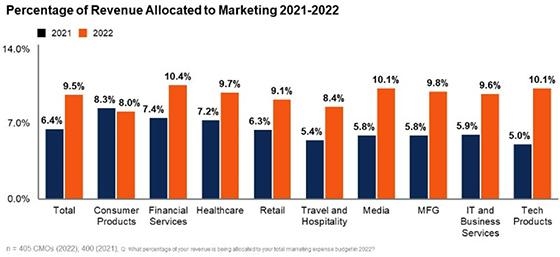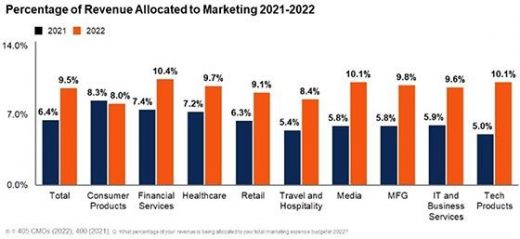Gartner: Marketing Budgets Increase To 9.5% Of Overall Company Revenue
Gartner: Marketing Budgets Increase To 9.5% Of Overall Company Revenue

Marketing budgets climbed to 9.5% of total company revenue in 2022 — up from 6.4% in 2021, but down from 11% in 2020 and 10.5% in 2019, according to Gartner.
The Gartner 2022 CMO Spend and Strategy Survey — released Monday at the Gartner Marketing Symposium/Xpo — found 70% of respondents reported budgets increasing this year.
The study was fielded between February through March 2022 among 405 CMOs and other marketing leaders in North America, as well as Northern and Western Europe across different industries.
Ewan McIntyre, chief of research and vice president analyst in the Gartner for Marketing Leaders practice, believes that despite inflation, Russia’s invasion of Ukraine and supply chain issues, CMOs appear sanguine.
Digital accounts for 56% of marketing spend, the data shows — but offline channels have rebounded.
When asked to report the proportion of their 2022 budget allocated to online and offline channels, CMOs said online channels took 56%, while offline channels account for 44%.
CMOs allocated 10.1% to social, 9.8% to search, 9.3% to digital display, 8.8% to digital video, 8.1% to partners and affiliates, 8.1% went to digital audio, and 7.4% went to digital-out-of home.
About 8.5% went to search engine optimization took, 7.8% to email, 7.8% to content and messaging, 7.6% to organic social and influencers, and 6.9% to SMS and in-app advertising.
The amount marketing will spend rose across nearly all industries. Financial services companies recorded the highest budget at 10.4% of company revenue, up from 7.4% in 2021. While eight out of the nine industries surveyed reported budget increases, spending for CMOs in consumer goods firms has stagnated, dropping slightly from 8.3% in 2021 to 8% in 2022.
Interesting that search-advertising budgets ranked among the highest in healthcare and tech products. In financial services, CMOs said they would allocate 10% of budgets, healthcare at 9.9%, tech products at 11.7%, manufacturing at 9%, consumer products at 10.6%, media at 8.6%, retail at 10.1%. IT and business at 10.3%, and travel and hospitality and 7.6%.
Among the highest budgets, marketers allocated 10.8% to email for financial services, and 12% to social advertising for consumer products.
Event marketing reached highest for most sectors such as financial services at 18.6%, healthcare at 21.3%, tech products at 22.3%, manufacturing at 18%, consumer products at 16.3%, media at 15.2%, retail at 16.8%, IT and business at 24.3%, and travel and hospitality at 16%.
Brand was one of the lowest ranked capability gaps in the survey — showing that CMOs are confident in their capabilities to manage brands.
When asked to report their budget allocations across marketing’s program and operational areas, brand strategy and activation were near the top of the list, accounting for nearly 10% of the budget.
Other strategic capabilities gaps still persist such as marketing data and analytics was identified by 26% of CMOs as a top capability gap, followed by customer understanding and experience management at 23%, and marketing technology at 22%.
(36)


